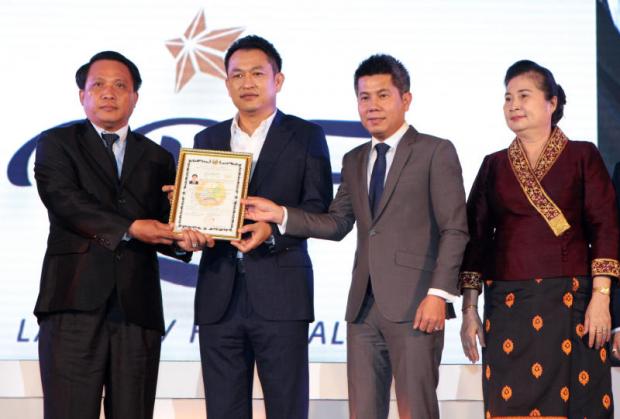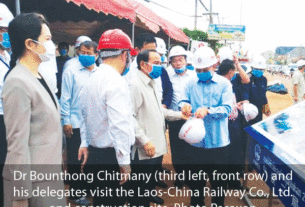A group of Thai and Lao business people have announced a plan to spend 10 billion baht to develop a large shopping and hotel complex in Vientiane in order to cash in on opportunities arising from the coming Asean Economic Community.
The massive complex on 200 rai has the support of the Lao government, which wants to draw more foreign investment to the landlocked country, they said.
Under the partnership, Sayam International Co led by Thai chairman Sayam Ramasoot will hold a 49% stake in BM Group, the project developer, with 51% held by a group of Lao businessmen headed by Phisith Banyadith, a member of the family that owns Dao-Heuang Group, the leading coffee and duty-free conglomerate in Laos.
BM Group was awarded the licence by the Lao government to build and operate the Lao Duty Free Mall on 20 rai of land, which requires 3.5 billion baht of investment for the first phase. The mall is slated to have 37,000 square metres hosting 200 popular brands.

Bounchom Ubonpaseuth, the Lao vice-minister of finance (left), awards a licence to BM Group’s Sayam Ramasoot (2nd left) and Phisith Banyadith (3rd left) to operate a duty-free mall near the Thai border. The group is planning a 10-billion-baht venture that will include a hotel, theme park, commercial space and a logistics centre. PAWAT LAOPAISARNTAKSIN
In the second phase, a large shopping mall with a hotel, theme park and commercial buildings will be developed on 100 rai of land, totalling 200,000 to 300,000 sq m of total space. A logistics and distribution centre is planned for the remaining 80 rai of land.
Funding to develop this massive project is expected to come from bank loans.
Mr Sayam said his company was interested in developing a duty-free mall project in Laos because it has over two decades of experience in trading in Cambodia, Laos, Myanmar and Vietnam.
“Our company is a pioneer concerning investment in Laos. During the past 20 years, we have seen its economy grow, driven by Lao government economic polices,” he said.
In particular, the opening of a special economic zone (SEZ) with investment privileges, infrastructure improvement and a growing tourism segment has created vast investment opportunities for retail business – especially in the form of a tax-free shopping mall, said Mr Sayam.
He said BM Group chose an SEZ as the investment site because of its proximity to the Thai-Lao Friendship Bridge 1 in Nong Khai province, where cross-border trade amounts to over 100 billion baht per year.
It is also close to a future junction of the high-speed train route planned for Nong Khai, making it convenient for investors to transport products.
In addition, investors are entitled to enjoy a number of privileges in Laos, including 100% foreign ownership, one-stop service for business registration and licensing, and waivers of business and import taxes.
Construction of the Lao Duty Free Mall is 70% complete, and it is slated to open in February next year.
The duty-free mall is meant to be a high-end destination for foreign tourists, especially Chinese and Thai visitors, as well as Lao customers.
BM Group expects about 10,000 visitors a day to visit the mall, with annual revenues of 3.5 billion baht, breaking even within five years.
Mr Phisith has a long experience managing duty-free shops in Laos. BM Group expects to mix the trading and logistics background of Mr Sayam in the region with the duty-free experience of Mr Phisith.
After the initial mall, BM Group hopes to build four more duty-free malls in Luang Prabang, Pakse, Savannakhet and Vientiane in the next three to four years.
Mr Phisith said Laos offered a lot of business opportunities as the government formulated a national economic development plan with a focus on revised investment promotion laws and tourism promotion to attract more foreign investment.
In addition to the perks listed above, investors in SEZs will also enjoy low labour costs and corporate income tax and VAT privileges in accordance with the nature of the investment.
In 2014 more than 4 million tourists visited Laos – including 2 million from Thailand and more than 1 million from Vietnam – generating income for the country in excess of 20 billion baht.
The high-speed train project that will connect China, Laos and Thailand is expected to be completed in five years. The transport line will be an essential support factor for the economic development of Laos both in terms of the logistics and tourism sectors.
The train line is expected to increase the number of tourists from China and Thailand to Laos by as many as 10 million per year.
The high-speed train project is expected to connect to Map Ta Phut on Thailand’s Eastern Seaboard, the country’s manufacturing hub, promoting logistics development and eventually economic growth for Laos.



